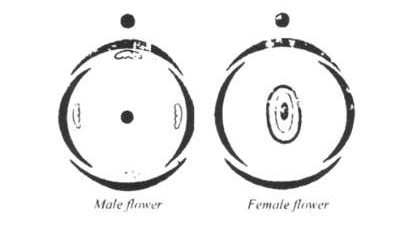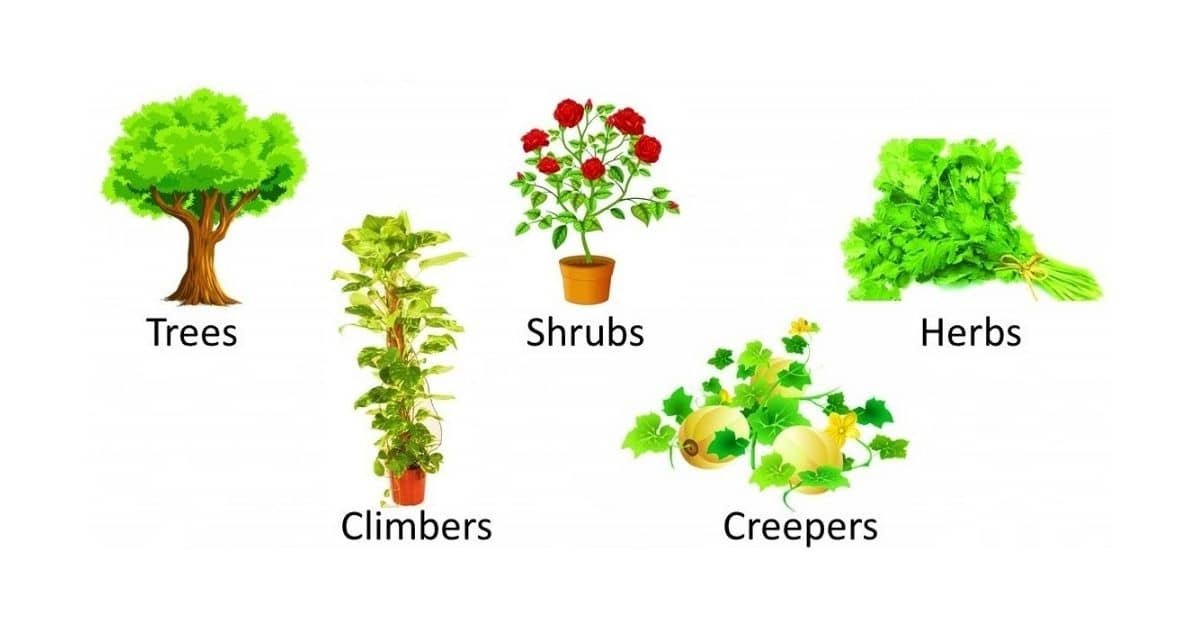Plant family characteristics are a vital study in crop botany. this article will discuss plant family characteristics, examples, and floral formula in brief.
Plant family characteristics and examples
Plant families include genetically related plants with similar blooms, reproductive mechanisms, and other traits. Similar plant families have similar growth and nutritional needs.
Gramineae or Poaceae:
- Herbaceous or seldom woody.
- Steam round, hallow with nodes called a culm.
- Leaves linear, parallel venation.
- The ligule is present at the junction of the leaf blade and leaf sheath.
- Inflorescence terminal panicle and axillary spikelets.
- Perianth scale-like.
- Flowers are trimerous, without sepals and petals.
- Spike is often present on bracts.
- Stamens and ovary are hidden inside bracts called palea and lemma.
- When flowering, styles, and anthers hang from spikelets.
- Ovary Superior with 1 ovule.
- Anthers are versatile.
- Stigmas are feathery.
- Placentation basal.
- Fruit caryopsis.
- Seeds Albuminous.
Example:
- Rice: Oryza sativa
- Sugarcane: Saccharum officinarum
- Wheat: Triticum aestivum
- Maize: Zea mays
- Bamboo: Bambusa vulgaris
Floral Formula: Br % ♀♂ P2(lodicules), A3 + 3 G1
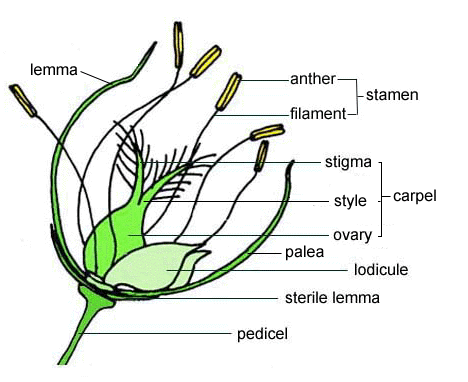
Leguminosae / Fabaceae
- Mostly herbaceous, with some trees and shrubs.
- Leaves alternate, and compound with many small leaflets.
- Stipules at the base of each leaf.
- Nodule present at the root.
- Flower semi perigynous.
- Corolla of butterfly type.
- Stamens 10, and 9 are often fused.
- Fruit legume (pod) and lomentum.
- Placentation marginal.
Leguminosae family is divided into 3 Sub-families:
- Papilionoideae
- Caesalpinioideae
- Mimosoideae
Papilionoideae
- Plant herbaceous, annual.
- Leaves alternate, compound, imparipinnate, stipulate.
- Flowers are zygomorphic and papilionaceous.
- Calyx gamosepalous.
- Corolla polypetalous, vaxillary aestivation.
- Ovary monocarpellary.
- Stamens 10, monadelphous or diadelphous (9+1).
- Placentation marginal.
- Fruit legume (pod), broad.
- Inflorescence Racemose.
- Nodule present.
Example:
- Chana: Cicer arietinum
- Soybean: Glycine max
- Garden pea: Pisum sativum
- Lentil: Lens esculenta.
Floral formula: Br % ⊕/♂♀ K5 C(1+2+2 , A(9)+1 G1
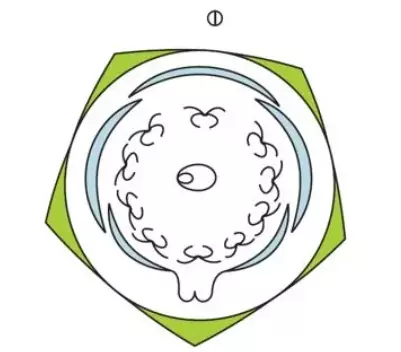

Caesalpinieae
- Plant mostly shrubs and trees.
- Leaves alternate, compound, paripinnate, stipulate.
- Flower irregular, caesalpinious, zygomorphic.
- Calyx gamosepalous.
- Corolla polypetalous, Imbricate aestivation.
- Ovary monocarpellary.
- Stamens 10 or fewer.
- Placentation marginal.
- Fruit legume (pod)
- Inflorescence compound racemose.
- Ovules anatropous
- Seeds non-endospermic
Example:
- Tamarind: Tamarindus indica
- Senna occidentalis: Cassia sophera
- Ashoka tree: Saraca indica
- Royal poinciana: Delonix regia
- Natay: Caesalpina crista
Floral formula: Br % ♀♂ K5 , C5, A10 G1

Mimosoideae
- Plants are mostly shrubs and trees.
- Leaves alternate, compound, bipinnate, stipulate.
- Flowers are small, inconspicuous, Actinomorphic
- Calyx gamosepalous.
- Corolla gamopetalous, aestivation valvate.
- Ovary monocarpellary.
- Stamen free, often many 0 to 10, rarely 4 to 8.
- Placentation marginal.
- Fruit usually lomentum.
- Inflorescence spherical head.
- Ovules are anatropous.
- Seed non-endospermic.
Example:
- Babla: Acacia nilotica
- Lajvanti: Mimosa pudica
- Khoer: Acacia moniliformis
- Rain tree: Samanea saman
Floral formula: Br ⊕/♀♂ K(5-4) C(5-4) Aα or 10 G1
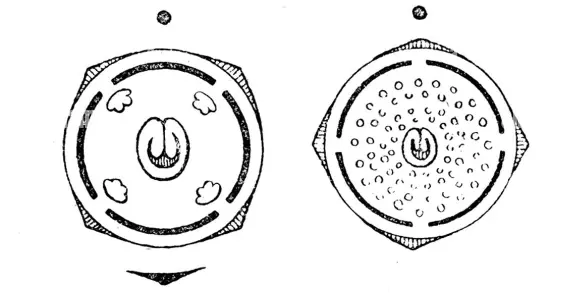

Distinguish characteristics of Leguminosae
| Subject | Papilionaceae | Caesalpinieae | Mimosoideae |
| Plant type | Herbaceous | Shrubs or tree | Shrubs or tree |
| Root type | Nodule present | Nodule absent | Nodule absent |
| Leaves | Imparipinnate | Paripinnate | Bipinnate |
| Flowers | IrregularPapilionaceousZygomorphic | IrregularCaesalpiniousZygomorphic | RegularActinomorphic |
| Corolla | Polypetalous, posterior petal largest and outermost | Polypetalous, posterior or petal smallest and innermost | Gamopetalous, all petals are equal |
| Aestivation( corolla ) | Vexillary | imbricate | valvate |
| Inflorescence | Simple racem | Compound racem | Spherical head |
| Calyx | GamosepalousImbricate | Polysepalous, sometime gamosepalous, imbricate | Gamosepalous, valvate |
| Androecium | Stamens 10(9)+1 rarely 10 | 10 or fewer, free | Often many or 10, rarely 4 to 8 |
| Pollen grains | Simple | Simple | Compound |
Solanaceae family
- Leaf simple, alternate.
- Calyx: The sepals are united and persistent
- The petals are united funnel or cup-shaped
- Stamens are epipetalous
- The ovary is superior
- Placentation axile
- Fruit berry or capsule
- Seeds are many, attached or center of the fruit
- Sepals and petals are 5 in number
- Flower solitary terminal or cymosely umbelled.
- Anther connate
Example:
- Potato: Solanum tuberosum
- Brinjal: Solanum meiongena
- Tobacco: Nicotina tabacum
- Dhatura: Datura metal
Floral formula: ⊕ ♀♂ K(5) C(5) A(5) G (2)
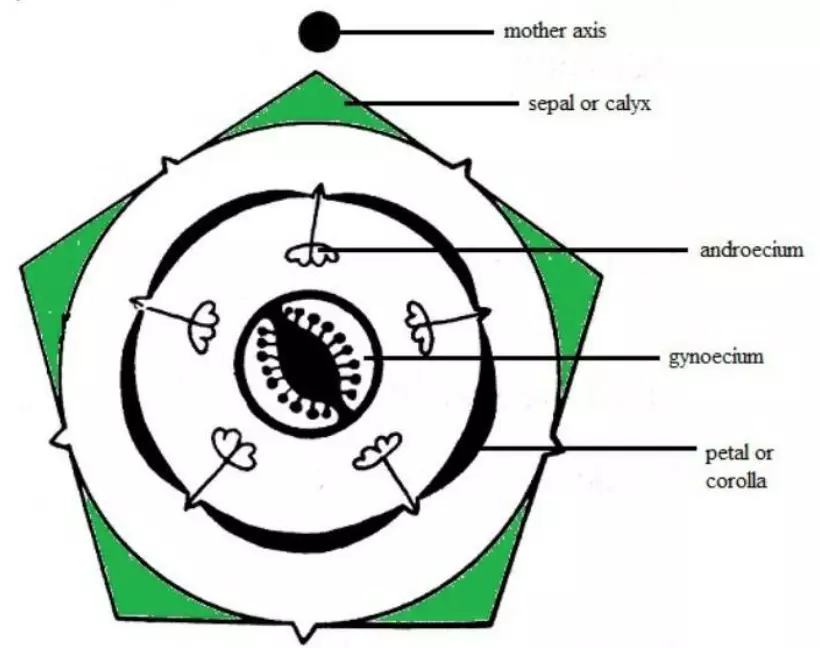

Cucurbitaceae
- Plants are Tendril climbers
- One tendril per node (extra axillary tendril)
- Leaf simple, alternate, petiolate, venation reticulate
- Flower incomplete, unisexual, pentamerous
- Thalamus cup-shaped
- Ovary inferior
- Corolla gamopetalous, valvate, campanulate
- Stamens Synandrous or syngenesious
- Anther sinuous
- Gynoecium tricarpellary
- Placentation parietal
- Fruit pepo
Example:
- Sweet gourd: Cucurbita maxima
- Cucumber: Cucumis sativas
- Muskmelon: Cucumis melo
- Lio: Laganuria vulgaris
Floral formula:
- Male: Ebr, ⊕ ♂ K(5) C(5) A(2) + (2 )+ 1, G0
- Female: Ebr, ⊕ ♀ K(5) C(5) A0 G(3)
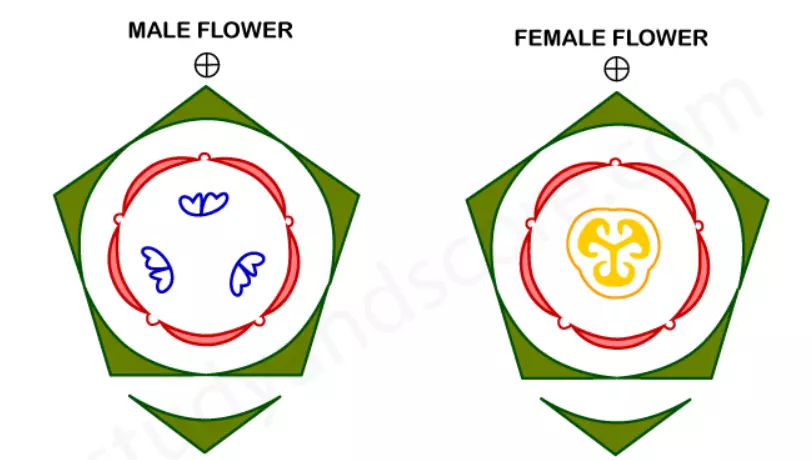

Compositae / Asteraceae
- Leaves are opposite or alternate, reticulate venation
- Inflorescence head or papitulum with many flowers and involucral bracts surrounding it
- Corolla tubular-shaped (disk floret) or ligulate shaped (ray floret)
- Calyx modified into a pappus
- Ovary inferior
- Stamens syngenesious and epipetalous
- Anthers are ring round style
- Gynoecium bicarpellary
- Placentation basal
- Fruit cypsela
- Aestivation valvate (corolla)
Example:
- Sunflower: Helianthus annuus
- Calendula: Calendula officinalis
- Jinia: Zinnia elegans
- Cosmos: Cosmos bipinnate
- Dalia: Dahlia hybrid
Floral formula:
- Ray floret: Br % ♀ K2 (pappus), C A0 G(2)
- Disk floret: Br ⊕ ♀♂ K2 (pappus), C(5) A(5) G(2)
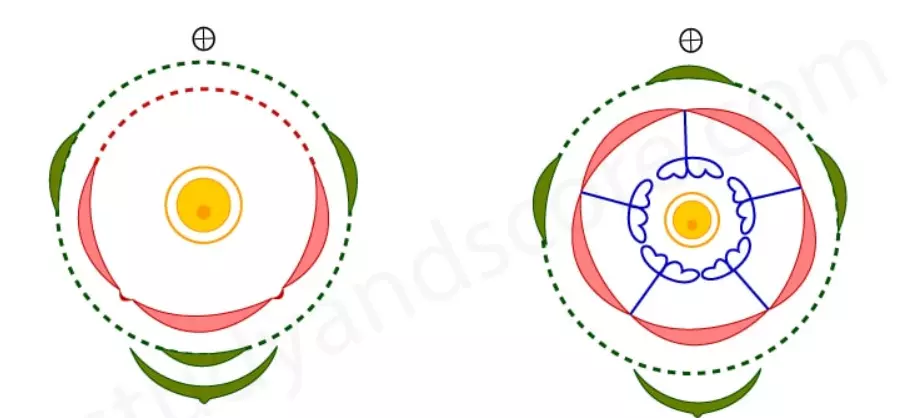

Distinguish between Ray Floret and Disk Floret
| Ray floret (female) | Disk floret |
| Present in the peripheral region of the inflorescence | Situated in the central inflorescence |
| Incomplete flower | Complete flower |
| Zygomorphic flower | Actinomorphic flower |
| Unisexual flower | Bisexual flower |
| Corolla ligulate, o/5 | Corolla tubular (5) |
| Androecium absent | Androecium present |
| Floral formula: Br, % ♀ K2 (pappas) C0/5 , A0 G(2) | Floral formula: Br, ⊕ ♀♂ K2(pappus) C(5) A(5) G(2) |
Umbelliferae / Apiaceae
- Mostly herbaceous, stem fistular.
- Plants are aromatic
- Leaf decompound, petiole, usually sheathing at the base
- Inflorescence umbel (like an umbrella)
- The outer flowers are protandrous
- The bracts are in the form of an involucre
- Sepals are free and adnate to the ovary
- Stamens are free, alternating with petals
- Anthers are intros
- Ovary inferior
- Stigma capitate
- Ovules pendulous
- Fruit schizocarp
Floral formula: ⊕ or % ♀♂ K5 C5 A5 G(2)
Example:
- Coriander: Coriandrum sativum
- Carrot: Daucus catofa
- Zira: Cuminum oyminum
- Mouri: Foeniculum vulgare
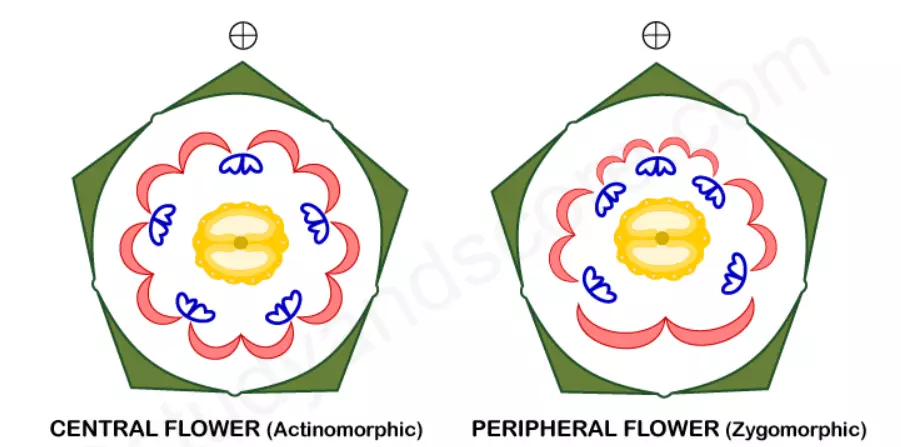

Rutaceae family
- Leaves exstipulate and contain aromatic oil glands
- Calyx gamosepalous, valvate
- Corolla polypetalous, imbricate, gland-dotted
- Flower hypogynous and ovary superior
- Stamens polyadelphous and obdiplostemonous
- Gynoecium multicarpellary
- A nectariferous annular disc is present below the ovary
- Placentation axile
- Stigma capitate
- Anther introrse
- Fruit hesperidium
Example:
- Citrus: Citrus medica
- Orange: Citrus aurantium
- Batabi lebu: Citrus grandis
- Kamini: Murraya exotica
Floral formula: Br ⊕, ♀♂ K(5-4) C(5-4) A( α, Polyadel ) G(α )

Anacardiaceae
- Resin canals present in wood
- Inflorescence panicle
- Flower hypogynous, ovary superior
- Cupular disc present between petals and ovary
- Stamens arise from the edge of an intrastaminal disc
- Ovary tricarpellary
- Stigma lobed
- Placentation axile
- Fruit drup
- Anthers are basifixed, introrse
Example:
- Mango: Mangifera indica
- Amra: Spondias dulcist
- Deshi Amra: Spondias mangifera
- Kaju nut: Anacardium occidentale
Floral formula: Br. Brl % ⊕ K5 , C5 A1 G(1)

Palme family
- Mostly unbranched tree
- Inflorescence Spadix
- Ptyxis – plicate (in the bud)
- Perianth and stamens are 6 in number
- Stamens dorsifixed, introrse
- Ovary superior and tricarpellary (female flower)
- Stigma short
- Fruit berry
- Perianth is persistent
- Leaves usually form a crown, sheath at the base of the leaf
Example:
- Supari: Cocos nucifera
- Coconut: Cocos catechu
- Khajur: Phoenix sylvestris
- Golpata: Nipa fruticans
Floral formula:
- Male: Br ⊕ ♂ P(3) + 3 A3 + 3 G0
- Female: Br ⊕ ♀ P(3) + 3 A0 G(3)
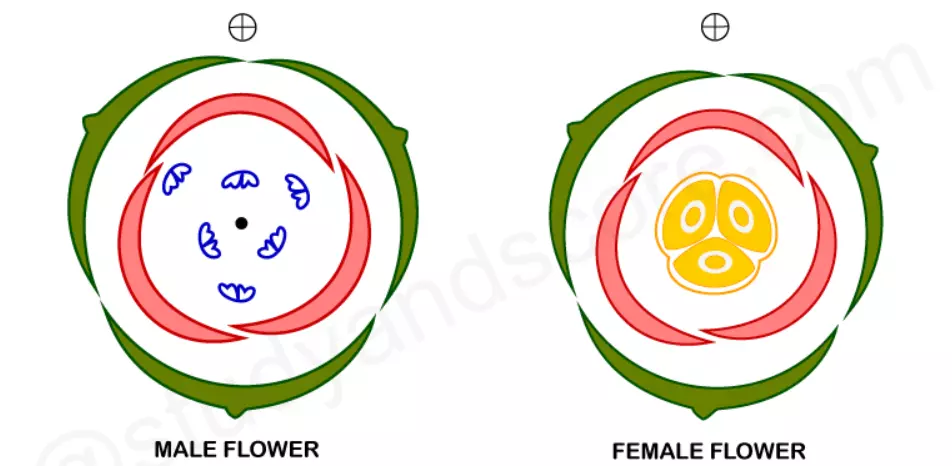

Cruciferae
- Leaf reticulate venation, upper leaves entire, lower lyrate
- Inflorescence raceme
- Corolla cruciform, Imbricate or valvate aestivation
- Petals separate, 4 in number
- Polypetalous calyx, imbricate aestivation
- Stamens tetradynamous, 6 in number
- Anther basifixed, introrse
- Ovary superior and bi-carpellary
- Style short, Stigma bilobed
- Placentation parietal
- Fruit siliqua
Example:
- Mustard: Brassica napus
- Radish: Raphanus sativas
- Cauliflower: Brassica oleraccava
- Tricum: Brassica compestous
Floral formula: Br ⊕ ♀♂ K2 + 2 C4 A2 + 4 G(2)
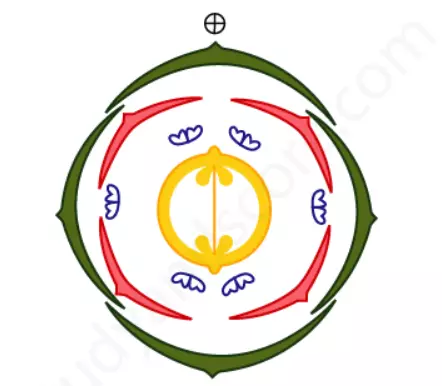

Malvaceae family
- Leaves stipulate, free lateral stipulate
- Calyx often with an epicalyx
- Inflorescence axillary
- Calyx gamosepalous, valvate
- Corolla polypetalous, twisted
- Stamens monadelphous, indefinite
- Anthers reniform (kidney-shaped)
- Ovary 3 to multi-carpellary, Superior
- Placentation axile
- Fruit capsule or schizocarp
- Pollen grain large and spined
- Style long, stigma round
Example:
- China rose: Hibiscus rosasinensis
- Ropes: Abelmoschus esculentus
- Karpas: Gossypium herbaceum
- Mesta Jute: Hibiscus sabdarifa
- Kenaf mesta jute: Hibiscus cannabinus
Floral formula: Ebr, ⊕ ♀♂ E5 – 8 K(5) C5 Aα G(5)

Orchidaceae
- The aerial roots are characterized by the special development of epiderms to form the velamen
- Steam leafy or scapose, monopodially branched
- Leaves alternate, whorled, often sheathing at base
- Inflorescence raceme
- Perianth in two whorls of 3 each
- The outer whorl calyx like and inner whorl make corolla
- The posterior median tepal of the inner whorl becomes much larger, the labellum
- Stamen united with the style to form column
- Pollen spread as pollinia
- Gynoecium tri-carpellary, inferior, indefinite ovules
- Stigmas 3, the third usually rudimentary
- Seeds minute
- Placentation parietal
- Inner perianth petaloid
- Fruit capsule
Example:
- Rasna: Vanda roxburghii
- Birds nest orchid: Neottia nidus-avis
- Coralroot orchid: Corallorhiza
- Butterfly orchid: Arundina graminifolia
Floral formula: Br, % ♀♂ P3 + 3 A1 G(3)
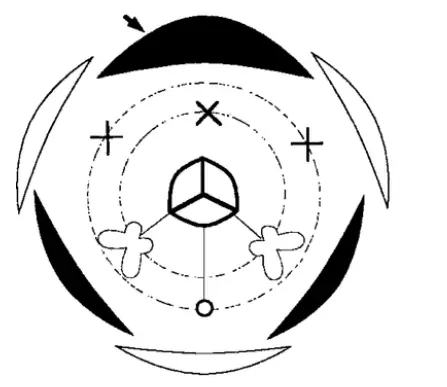

Moraceae family
- Leaves stipulate with latex
- Inflorescence catkin
- Flowers unisexually 1 whorl of the perianth, commonly sepaloid
- Stamens as many and opposite as tepals and antetepalous
- Peerianth sepaloid, polytepalous
- Gynoecium bicarpellary, superior
- Ovule pendulous
- Style short, 1, stigma two
- Anther basifixed, introrse
- Fruit sorosis
- Petals absent
Example:
- Jack fruit: Artocarpus heterophyllus
- Rubber: Hevea brasilensis
- Chapalish: Artocarpus chalasha
Floral formula:
- Male: Ebr, ⊕ ♂ P2 + 2 A4 G0
- Female: Ebr, ♀ P2 + 2 A6 G(2)
